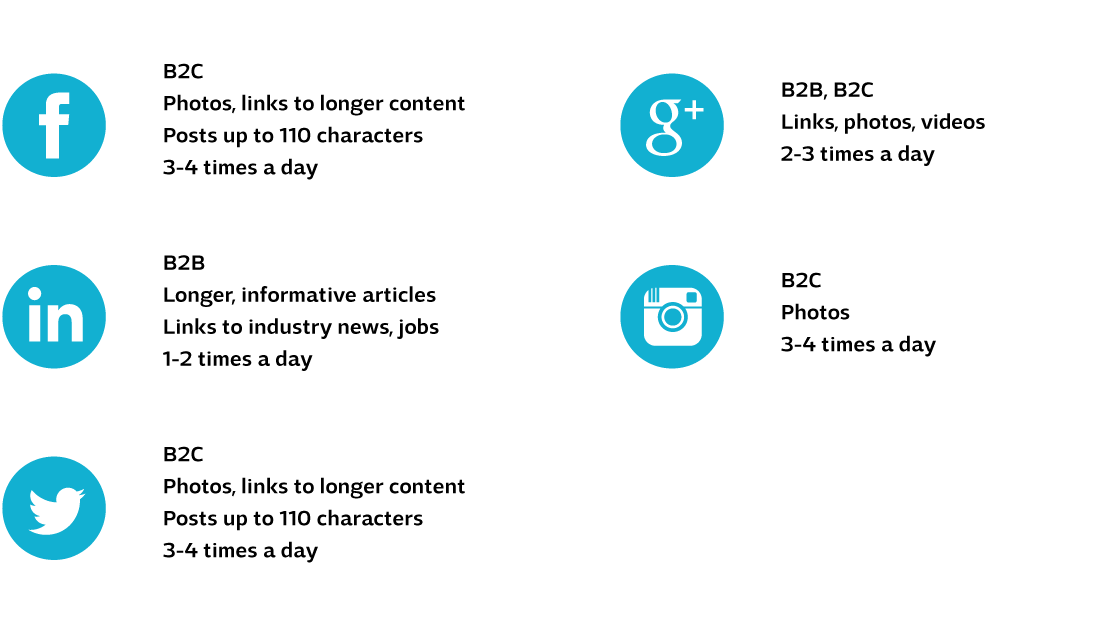 03
Aug, 2015
03
Aug, 2015
Our last article, Social Media Is Mostly Snake Oil, mentioned some of the misconceptions about social media, and some of the ways it’s misused and misadvertised.
This time, we’re taking a more positive approach. We’ve put together a selection of tips to help you set up, maintain and measure your social media presence and performance.
Here’s Sketch Corp’s guide on how to do social media.
Ask yourself: Why?
Without a clear goal, you’re going to flounder. Your presence on social media will be unfocused and directionless.
It might seem overly obvious to have to think about this, but you’d be amazed how many companies have trouble identifying a clear goal.
So ask yourself, what does your business want to achieve from social? Here are the four most common answers:
-
1.Sales and promotions
Pretty self-explanatory. We’re running a sale! Let’s tweet it! Let’s share it on Facebook! Let’s tweet a link to the Facebook post! Buy, buy, buy!
-
2.Better customer service
Do this right and you’re laughing. Very, very few brands do this right – or at all.
If you’re running a B2B business, you probably aren’t tweeting to your suppliers. But if you’re B2C, there’s a high chance your customers are going to be trying to find you via social media. Being contactable is vital.
-
3.Higher search rankings
If the only reason you’re on social media is to boost your SEO, you’re throwing away an enormous opportunity.
That said, publishing awesome content and getting it shared all over the internet by your loving audience will help your rankings. Now take those rankings and make sure you’re converting your leads!
Do you notice that none of these goals are directly related to social media itself? That’s right – these are all “business” goals, not “social” goals.
But wait, hang on. There’s one goal conspicuously absent from the above list. It’s a massive one, and it’s basically a combination of the three already listed.
Can you guess what it is?
-
4.Earning consumer trust and recognition
Generally speaking, the ultimate goal of any business is to make money. This is most commonly achieved by selling products or services.
Unfortunately for brands, being front and centre in customers’ minds at the moment they’re purchasing isn’t easy. Or affordable.
Brands therefore do what they can to build trust and recognition for their brand, so that the customer doesn’t need to be reminded that they exist when they want to buy.
In textbook speak, this trust and recognition is called “brand equity”, and it’s what most social media is geared towards.
The problem is that no one likes being interrupted by brand messaging while they’re liking posts, commenting on photos or sharing cat videos.
In short, people go on social media to socialise. They would never socialise with a business, so pretending to be their friend isn’t a particularly good tactic.
Trust is instead earned by providing the type of content the consumer wants, and this varies according to the market you’re targeting and the platform you’re using.
Which platforms should I use?
With social media profiles, more does not mean better.
The platforms you use, whether there are two or twenty of them, have only one purpose: to provide a medium for two-way communication between your business and its target audience.
Facebook, Twitter, Google Plus, LinkedIn, YouTube, Instagram, Pinterest… the list in almost endless. Don’t go for the shotgun approach – instead, pick your platforms based on who uses them, and then see how your objectives and content might fit in.
Here are a couple of rules of thumb for some of the usual suspects:
How, what and where to post?


The 80/20 rule
Ever heard of the 80/20 rule? You might also have heard it called the 70/20/10 rule.
It is the ratio of shared content vs. self-produced content. In the 70/20/10 rule, 10% is the maximum amount of overtly promotional posts.
As we mentioned earlier, nobody is interested in seeing your self-promotion. Keep it to a minimum! Trust isn’t earned by shouting sales messages at people – it’s earned by being relevant and helpful, and by building a brand persona that shares stuff that interests its customer base and target audience.
Look at Red Bull for example. Do you think about its old animations (“Red Bull gives you wings”), or do you think about its extreme sports stunts, racing team, and incredible array of other sponsorships and content partnerships?
Red Bull, thanks to awesome content and awesome social media, is now a media company with half a planet of fans, not just an energy drink company.
Measurement
We took the hatchet to “engagement” in our last article, but as we said, it’s only useless when it’s being measured as a KPI within itself.
It’s just too broad a number to be of much strategic use – the beauty of social media is that it can generate extremely detailed consumer analytics.
Here are three ways beginners can measure the results they’re getting from your social media. If you don’t have the tools or ability to do it, ask your friendly local marketing company. **ahem**
-
Measure the stats on the webpages your posts link back to
Use Google Analytics to monitor how many more people are visiting the page you’ve linked to. You can even create two unique pages and post two unique links, then A/B test which performs better.
-
Monitor social media for mentions of your brand after you’ve posted
Use tools like Social Mention to see how much your brand is being mentioned on social media compared to competitors.
-
Track your conversion rate
If you’re selling online (or even if you aren’t), try to mate your conversion rate stats to your social activity, especially content creation, sharing and links back to your website.
But remember: no single metric is a reliable indicator on its own. For example, if your conversion rate hasn’t changed after 6 months of working hard at your social media, this doesn’t necessarily mean your social isn’t working.
Look at your Google Analytics stats, and if people are visiting your site and leaving immediately, there’s a problem with your website, not your social.

But without a goal, measuring stats isn’t even that useful
Numbers tell you what’s going on, but unless you’re using them to inform decisions or measure against a pre-set KPI, there isn’t much point measuring them in the first place.
For example, “conversions” isn’t even a perfect metric when analysing your social media. In reality, any effect your social media will have had is most likely going to be “assisted” conversions, where someone has seen or lightly interacted with your brand – but without actually completing a purchase.
Tracking the more specific goals you set will help create a matrix of information, which you will then need to look at from above and draw a sort of ‘line of best fit’. This is where your own intuition and business knowledge will come into it.
Slow and steady wins the race
So you’ve created a piece of content and want it to go viral.
Good luck with that.

Content and social aren’t about fast results… not usually, anyway. As we said earlier, it’s about building trust and brand equity so that customers identify you as the company that best understands their needs.
Even Moz, arguably the world’s leader in content and social marketing, experiences around 7.5 customer visits before they even sign up for a free trial. And Moz spend an unearthly amount of time creating, promoting, sharing, tracking and improving their content model.
It’s a slow and steady race. The good thing is that few organisations really take the bull by the horns, so the longer you stick it out and evolve, the better your chance of creating those priceless positive interactions with your brand.
Right. Let’s get started.
Here are three very quick things you can do to get started.
-
1.Critique your content
Do you have a blog on your website? Has it been sitting there unused since the website was built?
Here’s a hot tip: 62% of companies have a blog of some sort, but almost 80% of these have five posts or less. No good.
Being better than this doesn’t take a lot of time, effort or money. Make a plan and stick to it.
-
2.Audit your social presence
How many social media profiles does your business have? Do they all have the correct logos, phone numbers, addresses, etc.?
Who manages these social accounts? Do you have a code of practice, or a calendar for when to post or share content?
Are people trying to contact you using these channels? Recent data shows that 5 out of 6 interactions with brands are never answered. This isn’t hard to beat.
-
3.Start a conversation
There’s no substitute to getting out there and getting stuck in.
Completed a project recently? Take photos (good ones, please) and upload them to Facebook.
Want to know something from your target market? Get out there and ask, but make sure to offer something in return.
OK, that’s about it for now. You’ve got a few things to get started with.
If this is all a bit daunting or complicated, don’t fret. There aren’t many brands that get social media completely right. For the most part, you just need to get started and learn while you go.
Or you can let Sketch Corp. manage your social media for you… give us a ring on 07 3352 6657 to find out what we can offer!
